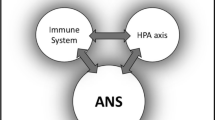Abstract
Rats were adapted to the continuous action of moderate immobilization stress for 1, 5, and 15 days. Thereafter the threshold of ventricular fibrillation and the heart rate were compared with biochemical indexes of adrenergic and cholinergic regulation of the heart, namely, catecholamine, cAMP, and cGMP content, acetylcholinesterase and choline acetyltransferase activity, the number and affinity of cardiac muscarinic receptors, and the catecholamine content in the adrenals. The threshold of ventricular fibrillation fell on the 1st day due to a predominance of the adrenergic regulatory effect over the cholinergic. Adaptation for 5 days is attended by a rise of the threshold of ventricular fibrillation to the norm and by marked bradycardia, both these shifts being abolished by atropine. Elevation of the heart's resistance to arrhythmias stems from the prevalence of cholinergic regulation. Equilibrium between the cholinergic and adrenergic effects on the heart was found as a results of 15-day adaptation. The normal threshold of ventricular fibrillation and the increased cardiac resistance to arrhythmia were preserved and dictated largely by adaptive changes at the cardiomycyte level.
Similar content being viewed by others
References
K. B. Vinnitskaya, V. A. Kuznetsov, I. L. Zhidkov,et al., Lab. Delo, No 7, 396–400 (1985).
E. Sh. Matlina and E. B. Rakhmanova,Studies on New Technology and Techniques [in Russian], Vol. 5, Moscow (1967), pp. 136–142.
F. Z. Meerson, L. M. Belkina, S. S. Dyusenov,et al., Kardiologiya, No, 10, 29–33 (1985).
F. Z. Meerson, V. I. Kuznetsov, and V. A. Saltykova,Kosm. Biol., No 2, 36–43 (1991).
F. Z. Meerson and I. Yu. Malyshev,The Phenomenon of Adaptive Stabilization of Structures and Protection of the Heart [in Russian], Moscow (1993).
F. Z. Meerson and M. G. Pshennikova,Stress-Limiting Systems of the Organism and New Principles of Prophylactic Cardiology [in Russian], Moscow (1989).
S. V. Trishkin, V. A. Kuznetsov, and K. B. Vinnitskaya,Vopr. Med. Khim.,39, No 1, 25–29 (1993).
H. C. Hartzell and R. Fishmeister,Nature,323, 237–275 (1986).
P. R. Lewis and C. C. D. Schute,in: Handbook of Psychopharmacology, Vol. 9, Eds. L. L. Iversenet al., New York-London (1978), pp. 315–497.
K. Loffelholz and A. J. Pappano,Pharmacol. Rev.,37, No 1, 1–24 (1985).
F. Z. Meerson, M. G. Pshennikova, L. M. Belkina,et al., Cardiovasc. World Report,2, 205–212 (1989).
L. Mikulaj, R. Kvetnansky, K. Murgas,et al., in:Catecholamines and Stress, New York (1976), pp. 445–455.
J. E. Skinner,in: Stress and Heart Disease, Eds. R. E. Beamishet al., Boston (1985), pp. 44–59.
S. Tucsek, M. Fatranska, R. Kvetnansky, J. Ricny, in:Stress: Neurochemical and Humoral Mechanisms, Eds. G. R. Van Loonet al., New York (1989), pp. 143–153.
J. W. Wei and P. V. Sulakhe,Naunyn Schmiedebergs Arch. Pharmacol.,309, No 11, 259–269 (1979).
Author information
Authors and Affiliations
Additional information
Translated fromByulleten' Eksperimental'noi Biologii i Meditsiny, Vol. 120. No 7, pp. 36–39, July, 1995
Rights and permissions
About this article
Cite this article
Pshennikova, M.G., Kuznetsov, V.I., Trishkin, S.V. et al. Role of cholinergic regulation of the heart in the protective antiarrhythmic effect of adaptation to continuous moderate stress. Bull Exp Biol Med 120, 681–684 (1995). https://doi.org/10.1007/BF02444659
Received:
Issue Date:
DOI: https://doi.org/10.1007/BF02444659




